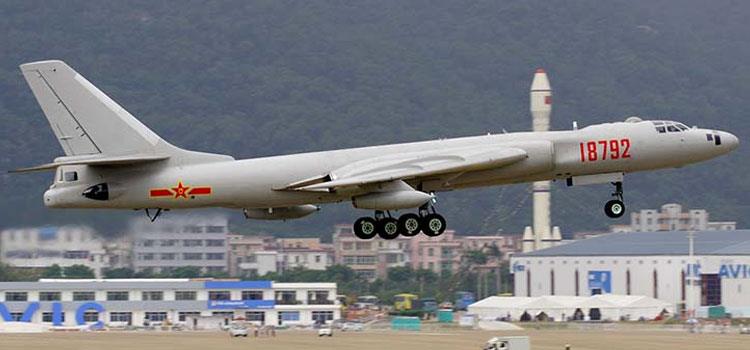S'sonic
Stealth
Menu
A free template by Lucknowwebs.com for WYSIWYG WebBuilder 8
Powered by Sispro1-S
Nigel G Wilcox
Paragon Of Space Publication
© Copyright Reserved - United Kingdom
Ideal Screen Composition 1024 x 768
SITEMAP
PSEUDO SCIENCE
SCIENCE RESEARCH
ABOUT
Desk
Supersonic
Stealth
Study
Menu
MAIN INDEX
Fastest Air Planes
Space
Transport
Menu
Xian H-6
The H-6 has been around for a few decades, but it’s still being used by China. The aircraft is powerful, capable of producing long-range attacks and engaging in prolonged stand-offs against opponents. Maximum speed: 1,050 km/h (652.44 mph) Range: 3,728 mi Maiden flight: 1959 Length: 114.17 ft Wingspan: 108.23 ft Passengers: 4
The Xian H-6 is a licence-built version of the Soviet Tupolev Tu-16 twin-engine jet bomber, built for the Chinese People's Liberation Army Air Force. Delivery of the Tu-16 to China began in 1958, and the Xi'an Aircraft Industrial Corporation signed a licence production agreement with the USSR to build the type in the late 1950s. The first Chinese Tu-16, or "H-6" as it was designated in Chinese service, flew in 1959. Production was performed by the plant at Xian, with at least 150 built into the 1990s. China is estimated to currently operate around 120 of the aircraft.
Design and development
The first domestically produced H-6 was completed in 1968 and evidence of bombing training was recorded by U.S. spy satellites on August 13, 1971. By March of the following year, the CIA estimated that the PRC had 32 aircraft operational with an additional 19 awaiting completion.
The H-6 was used to drop nine nuclear devices at the Lop Nur test site. However, with the increased development in ballistic missile technology, the nuclear delivery capabilities that the H-6 offered diminished in importance. The CIA estimated in 1976 that the H-6 had moved over to a dual nuclear/conventional bombing role.
Developed versions
Along with the H-6 free-fall bomber, an "H-6A" nuclear bomber was built, as well as an "H-6B" reconnaissance variant, "H-6C" conventional bomber and "H-6E" nuclear bomber with improved countermeasures, and the "H-6D" antiship missile carrier. The H-6D was introduced in the early 1980s and carried a C-601 antishipping missile (NATO codename "Silkworm", an air-launched derivative of the Soviet P-15 Termit ("Styx") under each wing. The H-6D featured various modernized systems and sports an enlarged radome with a Type 245 Kobalt I-band surveillance radar under the nose. The Type 245 radar was based on the Soviet PSBN-M-8 NATO codename Mushroom radar used on the Tupolev Tu-16. Earlier versions (Type 241, 242 and 244) were installed on the early models of the H-6. The H-6 has also been used as a tanker and drone launcher. Later H-6 production featured extended curved wingtips.
Many H-6A and H-6C aircraft were updated in the 1990s to the "H-6F" configuration, the main improvement being a modern navigation system, with a Global Positioning System (GPS) satellite constellation receiver, Doppler navigation radar, and inertial navigation system. New production began in the 1990s as well, with Xian building the "H-6G", which is a director for ground-launched cruise missiles; the "H-6H", which carries two land-attack cruise missiles. In terms of land attack cruise missiles five immediate possibilities were considered by PLAAF - the indigenous HN-1, HN-2 and HN-3, a cloned Tomahawk widely reported, likely to be the DH-10/CJ-10, and a variant of Russian designed cruise missile. It is believed CJ-10 is chosen to be the main land attack missile for H-6 bombers, and now the "H-6M" cruise missile carrier, which has four pylons for improved cruise missiles and is fitted with a terrain-following system. Apparently these variants have no internal bomb capability, and most or all of their defensive armament has been deleted.
The H-6K, first flying on 5 January 2007, entered service in October 2009 during the celebrations of the 60th anniversary of the People's Republic of China, and is claimed to make China the fourth country with a strategic bomber after US, Russia and the United Kingdom.With a reinforced structure making use of composite materials, enlarged engine inlets for Russian Soloviev D-30 turbofan engines giving a claimed combat radius of 3,500 kilometres (2,200 mi), a glass cockpit with large size LCD multi-function display, and a reworked nose section eliminating the glazed navigator's station in favour of a more powerful radar, the H-6K is a significantly more modern aircraft than earlier versions. The bomb bay has been replaced by extra fuel capacity, and six underwing pylons for CJ-10A cruise missiles. The rear 23 mm guns and gunner position are replaced by electronic components.
The H-6K is designed for long-range attacks and stand-off attacks. It is considered as a strategic bomber. It is capable of attacking US carrier battle groups and priority targets in Asia. This aircraft has nuclear strike capability.[9] While previous models had limited missile capacity (the H-6G could only carry two YJ-12 anti-ship missiles and the H-6M two KD-20/CJ-10K/CJ-20 land attack cruise missiles), the H-6K can carry up to six YJ-12 and 6-7 LACMs; a single regiment of 18 H-6Ks fully loaded out with YJ-12s can saturate enemy ships with over 100 supersonic missiles. Although the aircraft has a new nose radome housing a modern air-to-ground radar, it is not clear if the bomber or other Chinese assets yet have the capability to collect accurate targeting information for successful strikes against point targets in areas beyond the first island chain.
In January 2009, it was reported that an indigenous turbofan engine, the WS-18, was under development for use in the H-6K.
In 2015, about 15 H-6Ks were in service.
H-6N
The H-6N is an ASBM-carrier that is armed with a single DF-21D anti-ship ballistic missile or air launch to orbit (see Shenlong (spacecraft)) and equipped with an in-flight refueling probe. It made its maiden flight at the end of 2016.
Operational history
China has repeatedly used H-6 aircraft to perform long range drills near Japan, prompting the Japanese Air Self-Defense Force to scramble fighters.
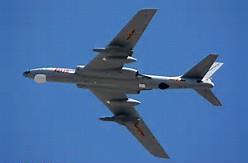
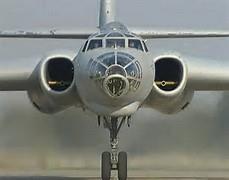
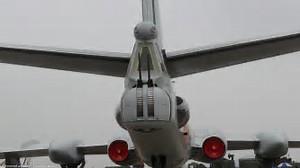
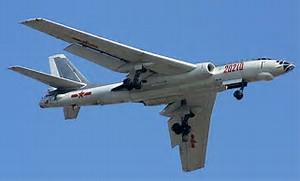
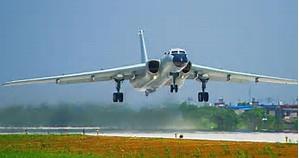

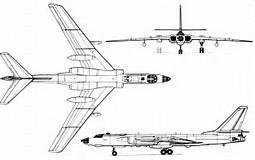
General characteristics
Crew: 4
Length: 34.8 m (114 ft 2 in)
Wingspan: 33.0 m (108 ft 3 in)
Height: 10.36 m (34 ft 0 in)
Wing area: 165 m² (1,775 ft²)
Empty weight: 37,200 kg (82,000 lb)
Loaded weight: 76,000 kg (168,000 lb)
Max. takeoff weight: 79,000 kg (174,000 lb)
Powerplant: 2 × Xian WP8 turbojets, 93.2 kN (20,900 lbf) each
Performance
Maximum speed: 1,050 km/h (567 knots, 656 mph)
Cruise speed: Mach 0.75 (768 km/h, 477 mph)
Range: 6,000 km (3,200 nm, 3,700 mi)
Combat radius: 1,800 km (970 nm, 1,100 mi)
Service ceiling: 12,800 m (42,000 ft)
Wing loading: 460 kg/m² (94 lb/ft²)
Thrust/weight: 0.24
Armament
Guns:
2× 23 mm (0.906 in) Nudelman-Rikhter NR-23 cannons in remote dorsal turret
2× NR-23 cannons in remote ventral turret
2× NR-23 cannons in manned tail turret
1× NR-23 cannons in nose (occasional addition)
Missiles:
6 or 7 KD-88 missile (anti-ship or air-to-surface)
YJ-100 (CJ-10) anti-ship missile
C-601 anti-ship missile
YJ-62 (C-602) anti-ship missile
C-301 anti-ship missile
C-101 anti-ship missile
CM-802A
YJ-12 anti-ship missile
DF-21D (H-6N)
Bombs: 9,000 kg (20,000 lb) of free-fall weapons
Guided bombs
GB6
CS/BBC5
GB2A
GB5
Role: Strategic bomber
Manufacturer: Xi'an Aircraft Industrial Corporation
First flight: 1959
Retired: Iraq (1991)
Egypt (2000)
Status: Active service with the PLAAF
Primary users: People's Liberation Army Air Force
People's Liberation Army Navy
Egyptian Air Force (historical)
Iraqi Air Force (historical)
Number built: 162-180
Developed from: Tupolev Tu-16



